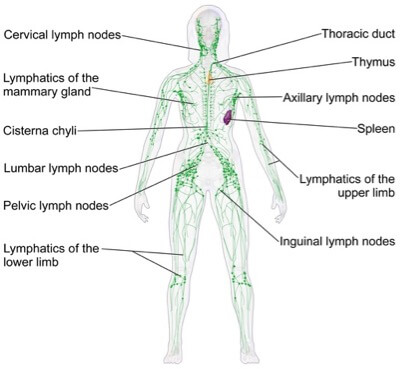- Home
- Western Massage
- Lymphatic Drainage
As an affiliate for Bookshop, Amazon, and other programs, I may earn a small commission for products purchased through links. This doesn't affect the price you pay. Privacy policy and disclosures.
Search this site:
What Is Lymphatic Drainage Massage?
The purpose of lymphatic drainage massage is to assist the movement of lymph fluid in the body to help reduce swelling and edema.
About the Lymphatic System
Lymph fluid starts out as interstitial fluid in the spaces between connective tissues. When the interstitial fluid enters the lymphatic capillaries, it's then called lymph. Lymph capillaries come together to form lymphatic vessels, which move the fluid into and out of lymph nodes and eventually back into the bloodstream.
The lymphatic system is an important part of the body's immune function. The lymph absorbs excess fluid, trapped proteins, dying cells, toxins, and foreign substances from the spaces around the cells. Lymph also carries vitamins, hormones, and plasma proteins needed by cells as building blocks of life. This process regulates the body's fluid volume and pressure and helps maintain the integrity of connective tissue.
Lymph does not circulate in the same way that blood circulates. Instead, body movement encourages the flow of lymph fluid through the body—one of many reasons exercise is so important. Manual lymphatic massage is another way to create movement that stimulates lymph flow. Gentle, specific strokes move the skin in the direction of the lymph flow and create a rhythmical motion that stimulates the lymphatic vessels, encouraging the flow of fluid.
What Is Lymphatic Drainage Massage?
Two main types of lymphatic massage are Manual Lymphatic Drainage (MLD®) and Lymph Drainage Therapy (LDT).
Danish doctor Emil Hans Vodder developed MLD in the 1930s. The technique uses gentle, pumping, circular movements with light pressure, combined with a resting phase. MLD Vodder's MLD technique is taught at the Dr. Vodder School International in 40-hour segments ranging from basic training to advanced courses.
Building on the work of Vodder, Bruno Chikly, MD, DO, developed Lymph Drainage Therapy (LDT). The technique is taught at the Chikily Health Institute, which offers two levels of certification.
You may also hear about three other types of lymphatic drainage massage, each with its own specific approach:
- Földi is an extension of the Vodder technique and emphasizes a thrust and relaxation phase. Földi's book is Foundations of Manual Lymph Drainage.
- Casley-Smith is based on the Földi method and uses a slow and gentle effleurage, with specific movements using the side of the hand.
- Leduc uses specific movement techniques known as call up (or inciting) and reabsorption.
All these techniques work in a similar way, using gentle movements to stretch and move the skin in the direction of lymph flow.
Benefits of Lymphatic Drainage Massage
A primary benefit of lymphatic massage is reducing fluid buildup (swelling) in the body. The massage has proven benefits for lymphedema, which is an excess collection of lymph fluid that can occur after surgery or due to some other medical conditions or injuries. Lymphedema is especially common after breast cancer surgery. Lymphatic drainage massage after surgery can minimize post-operative swelling, prevent scar tissue and fibrosis, and enhances skin texture and elasticity.
Lymphatic massage may also help with circulatory problems, ulcerations and other skin conditions, injuries that cause swelling, and burns.
Because the flow of lymph moves pathogens to the lymph nodes where they are removed from the body, lymphatic massage may benefit the immune system by helping those pathogens move more quickly out of the body. Plus, the massage may help lower blood pressure, reduce stress and improve sleeping patterns.
What Is Lymphatic Drainage Massage FAQs
Does a lymphatic massage work?
Lymphatic massage has proven benefits for people who have, or are at risk for developing, lymphedema. Studies have also found this type of may benefit these conditions, according to the Cleveland Clinic:
- Rheumatoid arthritis
- Fibromyalgia
- Chronic venous insufficiency (a condition where the valves or walls of the veins in the legs don't work well).
- Lipedema (a condition where fat in your lower body causes lymphedema that blocks lymph from draining through your lymphatic system)
The massage might support health and improve immune function for generally healthy people, but research hasn't yet proven those benefits.
Is lymphatic massage safe?
The massage is safe for most people. However, avoid it if you have:
- Blood clots or deep vein thrombosis
- Cellulitis (a bacterial skin infection) or any other infection or fever
- Heart disease, stroke, or kidney failure
Always tell your practitioner about all your medical conditions.
Does lymphatic massage hurt?
No, the technique is very gentle. If you do experience pain, let the practitioner know immediately.
Are there lymphatic massage side effects?
Side effects are uncommon. But a few people may experience fatigue, headaches, nausea, or mild soreness. If this happens, tell your practitioner, who may modify the techniques used or make suggestions for avoiding these side effects.
What are lymphatic system massage techniques?
Techniques include stretching, compressing, gliding, and cupping motions. Lymphatic massage has a specific sequence that starts with the main lymph drains, which include the lymph nodes in your neck, groin, and armpits.
This excerpt from the Lymphatic Drainage Massage DVD by Real Bodywork shows some of the techniques.
Can you use essential oils for lymphatic massage?
Although essential oils are not a typical part of most lymphatic massage, some practitioners may use them to enhance the session. Or you could use them at home for extra support. If you have a medical condition or are recently post-surgery, ask you healthcare provider if it's OK for you to use essential oils.
Massage Magazine suggests citrus oils to stimulate lymph flow and geranium essential oil to support lymphatic drainage and skin health. The article also notes that clove, eucalyptus, rose, and thyme may help with circulation, inflammation, and skin elasticity.
Suggested book: The Book of Lymph: Self-Care Practices to Enhance Immunity, Health, and Beauty
What Is Lymphatic Drainage Massage Sources
Anne Fiona Williams. Manual lymphatic drainage: Exploring the history and evidence base. British Journal of Community Nursing, April 2010.
Bruno Chikly and Sue Welfley, "Lymphedema," Massage Therapy Journal, Fall 2001.
Bruno Chikly, Lymph Drainage Therapy: An Effective Complement to Breast Care
Buy essential oils from Aromatics International (recommended).
Rocky Mountain Essential Oils.
Image Credit: Blausen.com staff (2014). Medical gallery of Blausen Medical 2014. WikiJournal of Medicine 1 (2). DOI:10.15347/wjm/2014.010. ISSN 2002-4436. CC3 via Wikimedia Commons




